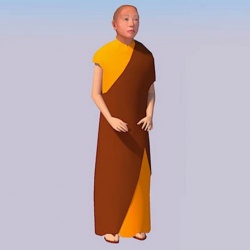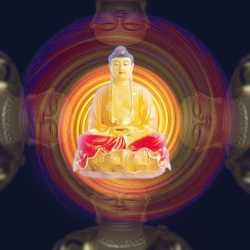Kathina: The Robe Offering
The Kathina festival is a major observance of Theravada Buddhism. It is a time for laypeople to offer cloth for robes and other necessities to the monastic sangha. Kathina takes place every year in the four weeks following the end of Vassa, the rains retreat.
Appreciating Kathina requires going back to the time of the Buddha and the first Buddhist monks. We begin with the story of some monks who spent a rainy season together. This story is from the Mahavagga, which is a section of the Pali Vinaya-pitaka. Monks and the Rains Retreat
The historical Buddha spent most of his life in India, which is known for its summer monsoon season. As the number of his followers grew, he realized that hundreds of monks and nuns traveling on foot through the sodden countryside could damage crops and injure wildlife.
So the Buddha made a rule that monks and nuns would not travel during the monsoon, but would spend the rainy season together in meditation and study.
This was the origin of Vassa, the annual three-month rains retreat still observed in parts of Asia with a rainy season. During Vassa, monks remain inside their monasteries and intensify their practice.
Once thirty forest-dwelling monks wished to spend the rainy season with the Buddha, and they traveled together to where he would be staying. Unfortunately the walk took longer than they anticipated, and the monsoons began before they had reached the Buddha's summer dwelling.
The thirty monks were disappointed but made the best of it. They found a place to stay together, and they meditated and studied together. And after three months, when the monsoon season ended, they hurried to find the Buddha.
But the roads were thick with mud, and rain still drizzled from the clouds and dripped from trees, and by the time they reached the Buddha their robes were muddy and drenched. They sat some distance from the Buddha, uncomfortable and probably embarrassed to be wearing such wet, dirty robes in the presence of their revered teacher.
But the Buddha greeted them warmly and asked how their retreat had gone. Had they lived together harmoniously? Had they had enough food? Yes, they said. Buddhist Monks' Robes
At this point it must be explained that it wasn't easy for a monk to get new robes. Under the rules of the Vinaya, monks could not buy cloth, or ask someone for cloth, or borrow robes from another monk.
Buddhist monks' and nuns' robes were to be made from "pure cloth," meaning cloth no one else wanted. So, monks and nuns scavenged in rubbish heaps looking for discarded cloth that had been scorched by fire, stained with blood, or even used as a shroud before cremation. The cloth would be boiled with vegetable matter such as bark, leaves, flowers, and spices, which usually gave the cloth an orange color (hence the name "saffron robe"). Monks sewed the bits of cloth together to make their own robes.
On top of that, the monastics were allowed to possess only the robes they wore, and they needed permission to take the time to scavenge for cloth. They were not allowed to keep leftover cloth for their own future use. So our muddy forest-dwelling monks resigned themselves to wearing moldy, muddy robes for their foreseeable futures. The Buddha Initiates Kathina
The Buddha perceived the sincere dedication of the forest-dwelling monks and felt compassion for them. A layperson had just given him a donation of cloth, and he gave this cloth to the monks to make a new robe for one among them. He also temporarily suspended some of the rules for all disciples who completed the Vassa retreat. For example, they were given more free time to see their families.
The Buddha also established a procedure for giving and receiving cloth to make robes.
In the month following the end of Vassa, gifts of cloth may be given to a sangha, or community, of monastics, but not to individual monks or nuns. Usually two monks are designated to accept cloth for the entire sangha. The cloth must be given freely and spontaneously; monastics may not ask for cloth or even hint that they could use some.
In those days, making a robe required spreading cloth on a frame called a "kathina," The word literally means "hard," and it also connotes stability and durability. So, Kathina is not just about cloth; it is also about firm commitment to monastic life. The Kathina Ceremony
Today Kathina is an important annual observance for devout lay Buddhists in Theravada countries. Along with cloth, laypeople bring other items monks may need, such as socks, stamps, tools, or fuel.
The exact procedure varies a bit, but usually on the designated day people begin to bring their donations to the temple early in the morning. In mid-morning there is a large community meal, with monks eating first, then laypeople. After this meal, people may come forward with their gifts, which are accepted by the designated monks.
Monks accept the cloth on behalf of the sangha, and then announce who will receive new robes once they are sewn. Traditionally, monks with unusually shabby robes are given priority, and after that the robes are designated according to seniority.
Once cloth is accepted, the monks begin cutting and sewing at once. Sewing of the robes should be completed that day. When the robes are sewn, usually in the evening, the new robes are ceremonially given to the monks designated to receive them.
Source
http://buddhism.about.com/od/thefirstbuddhists/a/Kathina.htm

